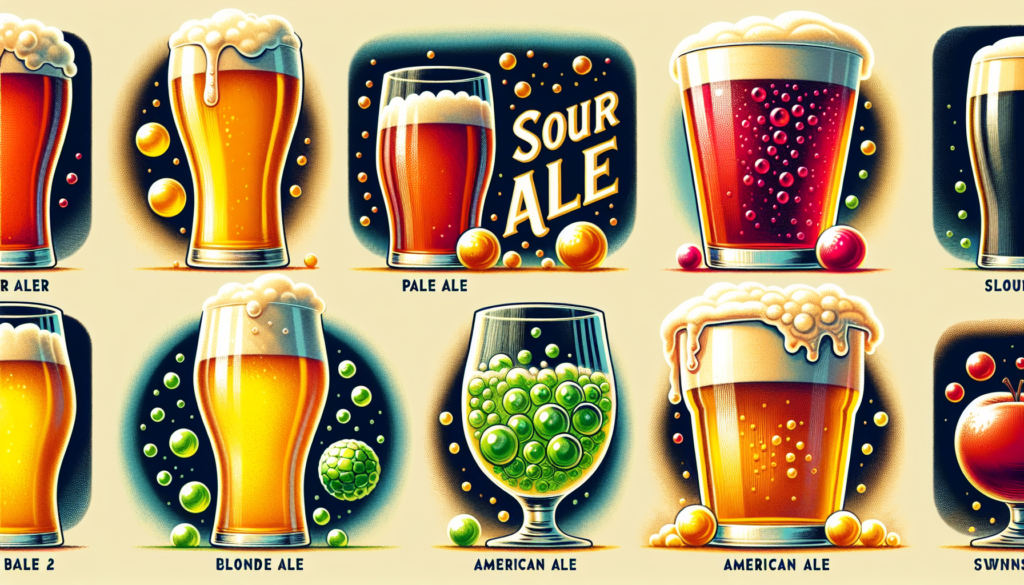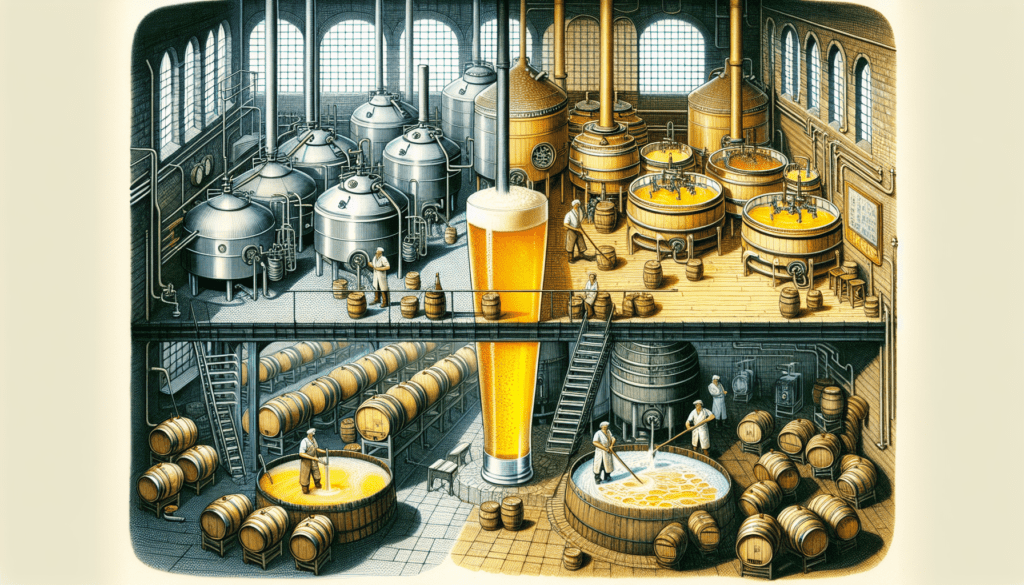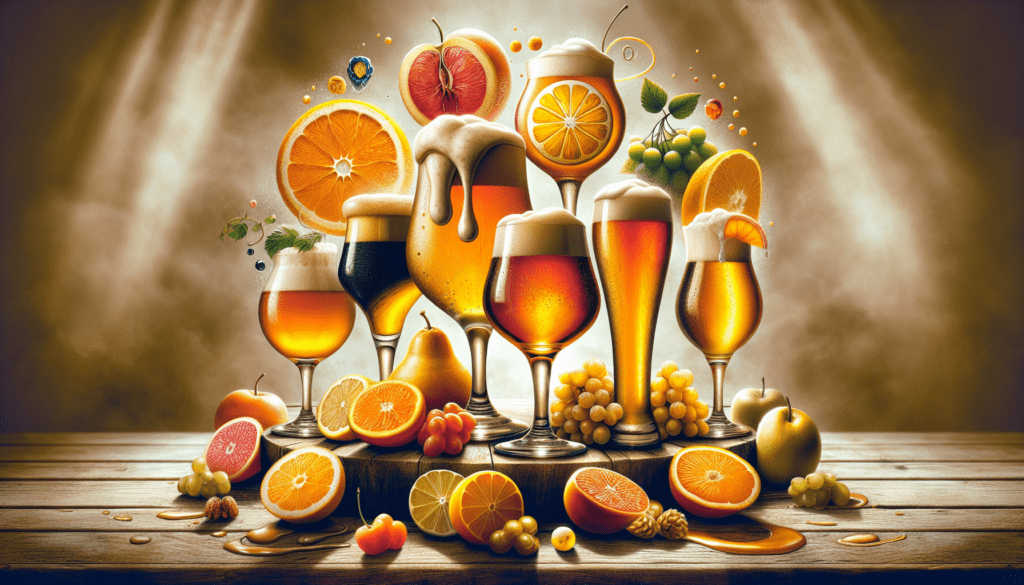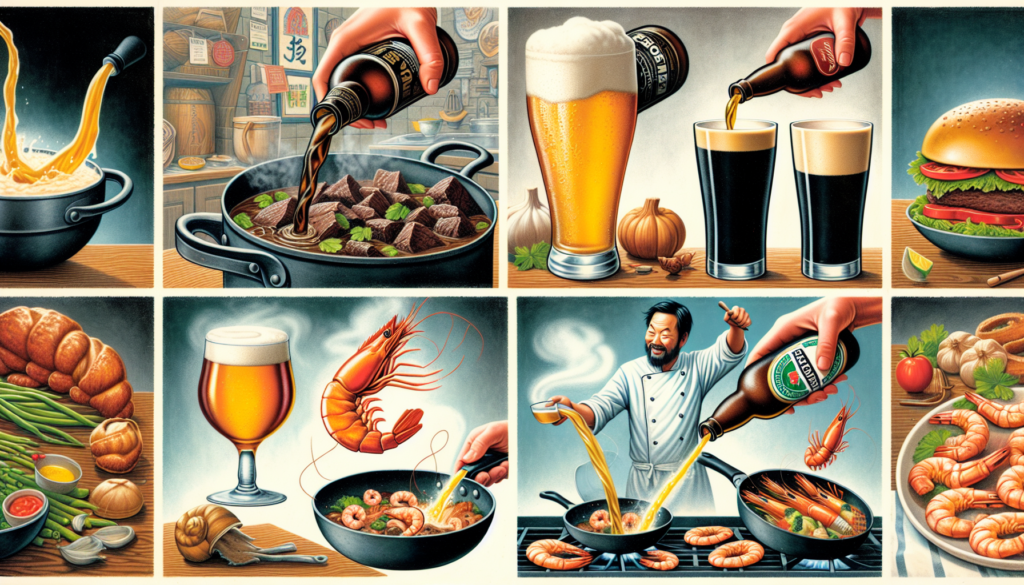Wondering what makes ales, lagers, and hybrid beers different? This guide on the difference in beer types breaks it all down. You’ll learn about the yeast and fermentation methods that give each beer its unique taste. We’ll also cover popular subcategories, so you can pick your next favorite brew with confidence.
Main Categories of Beer
Beer can be broadly classified into two main categories: ales and lagers, with some beers that combine elements of both categories known as hybrid beers. This classification is primarily based on the type of yeast used and the fermentation process. Understanding these categories is the first step in exploring the diverse beer styles available today.
Ales are fermented using top-fermenting yeast at warmer temperatures, typically ranging from 60˚ to 70˚F. This yeast type, known as ale yeast, ferments at the top of the fermentation vessel and produces flavorful esters that contribute to the distinctive flavors of ales. The warm fermentation process allows ales to develop rich and complex flavors in a relatively short period, making them popular among craft brewers.
On the other hand, lagers use bottom-fermenting yeast and are fermented at colder temperatures, typically between 35˚ and 50˚F. The lager yeast ferments at the bottom of the vessel and works more slowly, resulting in a cleaner and crisper taste. The longer fermentation and lagering process, which involves storing the beer at near-freezing temperatures, helps develop smooth and refined flavors.
Hybrid beers are a fascinating category that combines elements of both ales and lagers. These beers might use ale yeast but ferment at lager temperatures or vice versa, creating unique and innovative flavors that appeal to a wide range of beer enthusiasts. Examples include California Common and Kolsch, which we’ll explore in more detail later.
A grasp on the main categories of beer enhances your appreciation for the diverse and complex styles available. Regardless of your preference – be it the robust flavors of ales, lagers’ clean finish or the unique blends in hybrid beers, the beer world has something to offer everyone.
Ale Characteristics

Ales are known for their warm-temperature fermentation and the use of top-fermenting yeast. This type of yeast works best at temperatures between 60˚ and 70˚F, allowing for a faster fermentation process that can produce beer in as little as 7 days. The warm fermentation also results in the production of esters, which are compounds that contribute fruity and spicy flavors to the beer.
The diverse range of ale styles means there’s something to suit every taste. From the light and refreshing blonde ale to the rich and robust dark ales, ales offer a wide spectrum of flavors and aromas. The following subsections will delve into the characteristics of pale ales, dark ales, and wheat beers, highlighting some popular styles and examples.
Pale Ales
Pale ales are known for their distinct characteristics:
Copper color
Fruity aroma
Variety of styles, including American amber ale, American pale ale, blonde ale, and English pale ale
Medium-bodied and well-balanced
Noticeable hop bitterness that complements the malt flavors.
Take American pale ales as an example; their medium body and the prevalent use of American hops bestow upon them a unique bitterness and aromatic quality. Sierra Nevada Brewing Company’s Pale Ale and Smuttynose Shoals Pale Ale are noteworthy examples that exemplify this style’s defining balance between malt and hops.
Blonde ales, on the other hand, are:
lighter in color and body
have a fruity aroma
have a refreshing taste that makes them perfect for a hot summer day
typically have a lower alcohol content
These characteristics make them an easy-drinking option for those who prefer a milder flavor profile.
English pale ales, such as the classic English Bitter, are known for their balanced malt and hop character, often with a slight fruity or caramel note. These beers have a rich history and remain popular for their approachable and well-rounded flavors.
Dark Ales
Dark ales, including porters and stouts, are celebrated for their:
Deep color
Robust flavors
Distinctive aroma reminiscent of coffee and chocolate
Rich, malty sweetness
These qualities make dark ales a favorite among those who enjoy complex and hearty beer styles.
Porters stand out with their dark black hue and roasted malt notes, often bearing a fruity or dry flavor with a chocolatey touch that sets them apart from stouts. Deschutes Obsidian Stout and Guinness Draught are well-known examples that underscore the versatility and depth of flavor this style offers.
Stouts are another type of dark ale, known for their bold, roasted flavors and sometimes bitter coffee taste. These beers can vary widely in sweetness and bitterness, depending on their origin and brewing methods. Some characteristics of stouts include:
Bold, roasted flavors
Sometimes bitter coffee taste
Varying levels of sweetness and bitterness
Irish and English stouts are typically less bitter and have a smoother, sweeter profile compared to other stouts.
Dark ales pair wonderfully with desserts and hearty meals, adding a layer of complexity to the dining experience. Whether enjoyed on their own or with food, dark ales offer a rich and satisfying drinking experience.
Wheat Beers
Wheat beers are known for their soft, smooth flavor and hazy body. These beers are brewed with a significant proportion of wheat, which contributes to their unique texture and appearance. Wheat beers are often light and refreshing, making them a popular choice for warm weather.
Hefeweizen, a popular wheat beer subtype, is known for its cloudy look and notes of banana and clove. Its characteristic haze and smooth mouthfeel come from the high wheat and yeast content. Dreamweaver Wheat from Troegs Brewing Co. and Big Horn Hefeweizen from CB & Potts Restaurant & Brewery are popular examples famous for refreshing wheat flavors and fruity esters.
Other wheat beers, such as Belgian-style witbier, incorporate spices like coriander and orange peel, adding a layer of complexity to their flavor profile. These beers are often enjoyed for their refreshing and slightly tart taste, which pairs well with light dishes and salads.
Wheat beers are versatile and approachable, making them a great choice for those new to craft beer or looking for a lighter option. With their soft flavors and smooth finish, wheat beers are a delightful addition to any beer lover’s repertoire.
Lager Characteristics

Lagers are fermented with yeast from the Saccharomyces pastorianus family, which works at cooler temperatures below 50°F. This bottom-fermenting yeast is considered ‘cleaner’ because it consumes some sugars that ale yeast cannot, resulting in a crisper and cleaner taste. The primary fermentation of lagers occurs at these cooler temperatures, followed by a lagering process where the beer is stored at near-freezing temperatures for 6-8 weeks.
The prolonged fermentation and maturation process lends lagers a smooth and polished flavor, making them a favored option for those who prefer a clean, refreshing beer. The subsequent subsections delve into the traits of pale lagers and dark lagers, accentuating some well-liked styles and examples.
Pale Lagers
Pale lagers are known for their light amber color and crisp taste. These beers are highly carbonated and have a refreshing quality that makes them ideal for hot weather. Pilsners, a popular type of pale lager, are distinguished by their clear appearance and pronounced hop character. In fact, both lager beers, pale lagers and pilsners, share these appealing characteristics.
When it comes to American lager beers, some popular examples include:
Budweiser
Coors
Miller
Pabst Blue Ribbon
are popular pale lagers. They are recognized for their light, refreshing taste and mild flavor, which contributes to their high drinkability and makes them a staple in the beer market. Their light and crisp character makes pale lagers an ideal option for casual drinking and social gatherings.
Pilsners, another subtype of pale lager, are characterized by their hoppy nature and clear, golden appearance. These beers originated in the Czech Republic and have become a beloved style worldwide. Their crisp and refreshing taste, combined with a subtle bitterness, makes them a versatile and enjoyable beer.
Overall, pale lagers are an excellent choice for those who prefer a light and easy-drinking beer. Their clean flavors and refreshing qualities make them a go-to option for many beer lovers.
Dark Lagers
Dark lagers are characterized by their rich, malty sweetness and darker color. These beers offer a depth of flavor that includes notes of caramel, toffee, and sometimes roasted nuts. Bocks and dunkels are common examples of dark lagers, each with its own unique characteristics.
Bocks, for instance, are strong, malty beers that originate from Germany. They come in various sub-styles, such as doppelbock and maibock, which differ in color, alcohol content, and hop bitterness. Shiner Bock and Samuel Adams Chocolate Bock are two popular examples of bock beers. They are well-known and enjoyed by many beer enthusiasts.
Dunkels are another type of dark lager, known for their smooth and slightly sweet flavor. These beers have a rich amber to dark brown color and a malt-forward taste that is both comforting and satisfying. Dunkels are less intense than bocks but still offer a delightful drinking experience.
Dark lagers are perfect for those who enjoy complex and malty flavors. They pair well with hearty dishes and desserts, making them a versatile choice for various dining occasions.
Hybrid Beers
Hybrid beers are an intriguing category that combines elements of both ales and lagers. These beers may use ale yeast but ferment at lager temperatures or vice versa, resulting in unique flavors and characteristics. Hybrid beers often appeal to those who enjoy experimenting with different beer styles and flavors.
One well-known hybrid beer is the California Common, also known as Steam Beer. This style uses lager yeast but ferments at warmer ale temperatures, creating a beer with a clean yet robust flavor profile. Another example is Kolsch, a German-style beer that is light, slightly dry, and crisp with a hint of sweetness.
Kolsch beers are perfect for hot summer days due to their refreshing qualities and low bitterness. Two popular examples of Kolsch are Altstadt Kolsch and Rogue Honey Kolsch. These are well-known varieties enjoyed by many beer enthusiasts. These beers offer a delightful blend of ale and lager characteristics, making them a favorite among many beer enthusiasts.
Hybrid beers exemplify the creativity and innovation of craft brewers, pushing the limits of conventional beer styles to concoct something novel and thrilling. Regardless of whether you’re an ale aficionado or a lager enthusiast, hybrid beers provide a distinctive tasting experience worth delving into.
Specialty Beer Styles

Specialty beer styles are unique varieties that don’t fit neatly into the traditional ale or lager categories. These beers often feature unconventional ingredients, fermentation methods, or flavor profiles, making them stand out in the beer market.
Specialty beers include sour beers, Belgian beers, and various styles of India Pale Ales (IPAs).
Sour Beers
Sour beers offer a tangy and tart flavor experience that is both unique and refreshing, while avoiding the bitter taste often associated with other beer styles. These beers are often brewed using traditional souring methods, such as the introduction of Lactobacillus and Pediococcus bacteria early in the brewing process. Sour mashing and kettle souring are also common techniques used to achieve the desired tartness.
Popular types of sour beers include:
Lambics: undergo spontaneous fermentation using wild yeasts, resulting in a complex and funky flavor profile
Goses: known for their salty and slightly sour taste
Flanders ales: often aged in oak barrels to develop their rich and fruity flavors.
Fruity and sour beers pair wonderfully with a variety of foods, including cheeses and fruit dishes. They are also perfect for those who enjoy a tangy twist in their beverages. Sour beers encompass a wide variety of styles, with examples including Belgian-style lambic beer, which is known for its tartness, as well as fruity Flanders ale and lemony Berliner Weisse beer. Each style offers its own distinct characteristics and flavor profiles.
Sour beers, also known as sour ales, are a testament to the creativity and experimentation within the craft beer world. Their unique flavors and brewing processes make them a fascinating and enjoyable category to explore, especially for those who are fans of sour beer.
Belgian Beers
Belgian beers are renowned for their:
Complex flavor profiles
Inclusion of spices like coriander and orange peel
Rich, malty character
High alcohol content
These qualities make them a favorite among beer enthusiasts who appreciate depth and complexity.
Belgian Dubbel and Tripel beers are prime examples of this style. Dubbels are typically darker and have a rich, malty sweetness, while Tripels are lighter in color but higher in alcohol content. Both styles offer a delightful blend of flavors that can include fruity, spicy, and caramel notes.
These beers are perfect for pairing with hearty dishes, such as Flemish beef stew, which benefits from the robust flavors of a dark Belgian-style ale. Belgian beers are also ideal for sipping and savoring, allowing you to fully appreciate their intricate flavor profiles.
Exploring Belgian beers is like taking a journey through the history and tradition of Belgian brewing. Their unique and diverse flavors make them a must-try for any beer lover.
India Pale Ales (IPAs)
India Pale Ale, also known as IPA, is known for its hoppy and bitter flavors, making it a popular choice among those who enjoy bold and intense beers. The IPA style originated in Britain, where extra hops were added to pale ales to help preserve them during long sea voyages to India. This resulted in a beer with a pronounced bitterness and often fruity, citrusy flavors.
Different prominent styles of IPAs include:
West Coast IPA: known for their clear appearance and strong hop character
British IPA: typically have a more balanced malt profile compared to their American counterparts
New England Style IPA: hazy and feature juicy, fruity flavors with lower bitterness
Each style offers unique flavor profiles and characteristics, including a fruity flavor.
IPAs pair well with spicy or richly flavored foods, as their bitterness can balance out strong flavors. Trying a variety of IPA types can help you discover your favorites, whether you prefer the resinous pine notes of a West Coast IPA or the tropical fruit flavors of a New England Style IPA.
The diverse range of IPAs offers something for every hop lover, making them one of the most exciting and dynamic categories in the beer world.
Choosing the Right Beer for You
The journey to choosing the right beer begins with recognizing your unique taste preferences. Whether you’re drawn to sour beer tastes, the sweetness of malt, or the bitterness of hops, a beer style exists that will complement your palate. Craft beers present a broad spectrum of flavors, accommodating diverse preferences and events.
When selecting a beer, consider starting with styles you think you would enjoy based on your existing taste preferences. This approach can help you avoid being overwhelmed by unfamiliar flavors and gradually expand your beer repertoire. Additionally, considering the alcohol content and your tolerance can help you choose beers that are appropriate for different drinking occasions.
Seasonal recommendations also play a significant role in selecting the perfect beer. Light and crisp beers like Pilsners and Kölsch are ideal for hot summer days, while spiced ales and pumpkin beers capture the essence of fall and winter.
By understanding your preferences and experimenting with different styles, you can discover the wide world of beer and find your favorites.
Consider Your Taste Preferences
Your taste preferences are a crucial factor in choosing the right beer. If you enjoy light and crisp flavors, beers like Pilsners or Kölsch might be your go-to options. These beers offer a clean and refreshing taste that is perfect for casual drinking and social occasions.
For those who appreciate a pronounced bitterness, hoppy beers like IPAs are an excellent choice. The bold flavors and aromatic qualities of IPAs make them a favorite among hop enthusiasts. On the other hand, if you prefer malty sweetness, dark lagers or ales might be more to your liking.
Experimenting with different beer styles based on your taste preferences can help you discover new favorites and expand your beer knowledge. Whether you prefer light and refreshing or bold and bitter, there’s a beer out there that will suit your palate.
Alcohol Content and Tolerance
When choosing a beer, it’s essential to consider the alcohol content and your tolerance. Beers typically range from 3% to 13% ABV, with most falling between 4% and 7%. For those with low alcohol tolerance, starting with low ABV beers like session beers or non-alcoholic options is recommended.
Low ABV beers are perfect for extended drinking sessions and social occasions, allowing you to enjoy multiple beers without feeling overwhelmed by the alcohol content. Moderate ABV beers offer a balance between flavor and potency, making them suitable for various occasions.
High ABV beers, often referred to as “sipping beers,” are meant for savoring due to their potency and complex flavor profiles. These beers are ideal for special occasions or when you want to enjoy a beer slowly and appreciate its depth.
Understanding your alcohol tolerance and choosing beers accordingly can enhance your drinking experience and ensure you enjoy beer safely and responsibly.
Seasonal Recommendations
Seasonal beers offer a delightful way to enjoy beers that complement the changing weather and festivities. For summer, light and crisp beers like fresh hop ales are typically released, providing refreshing and vibrant flavors perfect for hot days.
In the fall, pumpkin ales become a popular choice, embracing the flavors and warmth of autumn. These beers often feature spices like cinnamon, nutmeg, and allspice, making them a cozy and comforting option. Winter brings spiced ales, which are enjoyed during the holiday season and offer rich and warming flavors with spices like nutmeg and cinnamon.
Different seasons bring an array of beer options that suit the changing weather and seasonal festivities. Exploring seasonal beers can add variety to your beer drinking experience and help you discover new favorites throughout the year.
Cooking with Beer

Integrating beer into your cooking can amplify the flavors of a variety of dishes, from savory meals to sweet desserts. The distinctive flavors of different beer styles can instill depth and intricacy into your culinary ventures, making it a beloved ingredient among both chefs and home cooking enthusiasts.
For savory dishes, here are some ways you can use different types of beer:
Amber ale is perfect for beer-braised pot roast, adding a rich and robust flavor to the meat.
Amber beer also brings a bite and some bitterness to homemade chili in a Frito Pie, enhancing the dish’s overall taste.
Lager can be used in batter for blue crab beignets or fried cheese curds, imparting an amazing crunch to the fried foods.
Beer can also be used in seafood dishes, such as beer-steamed shrimp or mussels steamed in reduced lager. These dishes are simple to prepare and offer a delicious way to incorporate beer into your cooking.
For desserts, porter can be used in a cake recipe for a rich and flavorful treat. Brown ale adds flavor complexity to pizza dough, making it a unique and tasty option for homemade pizzas. Guinness, a popular stout, can be used to make ice cream with chocolate-covered pretzels, offering a delightful and indulgent dessert.
Cooking with beer opens up a world of culinary possibilities, allowing you to experiment with different flavors and create delicious dishes that showcase the versatility of beer.
Summary
Exploring the diverse world of beer can be a rewarding and enjoyable experience. From the main categories of ales and lagers to the unique flavors of hybrid and specialty beers, there’s something for every palate. Understanding the characteristics of different beer styles can help you appreciate the complexity and craftsmanship that goes into brewing each variety.
When choosing the right beer for you, consider your taste preferences, alcohol tolerance, and the season. Whether you prefer light and crisp beers, hoppy and bitter IPAs, or rich and malty dark ales, there’s a beer out there that will suit your taste. Seasonal beers also offer a delightful way to enjoy flavors that complement the changing weather and festivities.
Cooking with beer is another exciting way to explore its versatility. Incorporating different beer styles into your dishes can enhance their flavors and create unique culinary experiences. From savory meals to indulgent desserts, beer can be a fantastic ingredient in the kitchen.
In conclusion, the world of beer is vast and diverse, offering endless opportunities for exploration and enjoyment. So, go ahead and try different styles, experiment with cooking, and find your favorites. Cheers to the wonderful world of beer!
Frequently Asked Questions
What are the main categories of beer?
The main categories of beer are ales and lagers, with hybrid beers that combine elements of both. Ales are fermented with top-fermenting yeast at warmer temperatures, while lagers use bottom-fermenting yeast and are fermented at cooler temperatures. Cheers!
What is the difference between pale ales and dark ales?
Pale ales are characterized by a copper color and fruity scent, while dark ales like porters and stouts have a roasted malt aroma with flavors of coffee and chocolate. So, the main difference lies in their color and flavor profiles.
What are some popular styles of sour beers?
So, popular styles of sour beers include lambics, goses, and Flanders ales. They are well-loved for their tangy and tart flavors, usually achieved through traditional souring methods. Cheers!
How do I choose the right beer for my taste preferences?
Consider your taste preferences, such as whether you prefer light and crisp flavors or hoppy and bitter ones. Experimenting with different beer styles based on your preferences can help you discover new favorites. Cheers!
Can I use beer in cooking?
Absolutely! Beer can add depth and complexity to your dishes, enhancing their flavors, whether you’re cooking savory meals, desserts, or marinades. Cheers to trying it out!

Leave a Reply